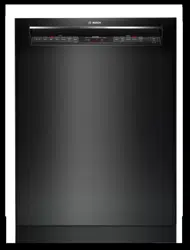Documents: Go to download!
User Manual
- Owner's manual - (English)
- Supplemental - (English)
- Getting Started
- Rinse AidS
- Loading the Dishwasher
- Detergent
- Dishwasher Cycles
- Dishwasher Cycle Options
- Operating the Dishwasher
- Care and Maintenance
- Troubleshooting
Table of contents
Instruction manual Dishwasher
Getting Started
Appliance overview
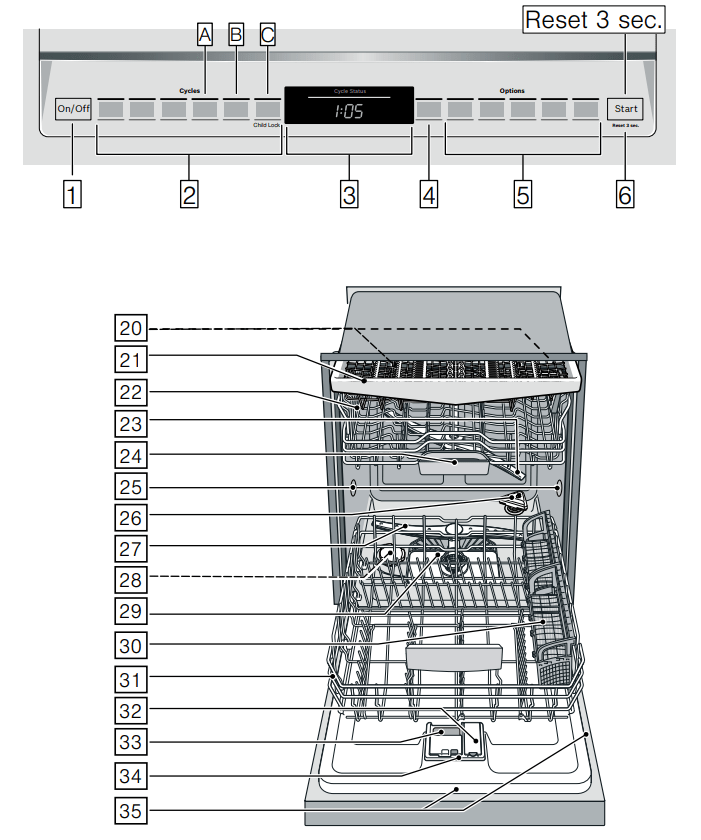
The dotted lines show optional features which may or may not be included with your dishwasher. The numbers stated below refer to the overview images on the previous page of this manual.
Operating panel
- On/Off button
- Wash cycles
- Digital display
- Delay start button
- Wash cycle options
- Start button
Note: Some of the wash cycles and options will vary by model.
Dishwasher interior components
20. Interior light *
21. Third rack
22. Upper rack
23. Upper spray arm
24. Detergent tab tray
25. Vent hole
26. Zeolite outlet cover (zeolite container)
27. Lower spray arm
28. Dispenser for special salt *
29. Filters
30. Silverware basket *
31. Lower rack
32. Rinse aid dispenser
33. Detergent dispenser
34. Lock for detergent dispenser
35. Rating plate
* optional feature which may or may not be included with your dishwasher.
Display indicators
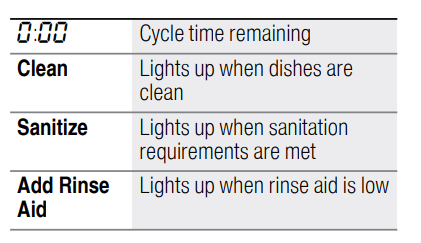
* optional feature which may or may not be included with your dishwasher.
Menu overview
The dishwasher has been preset with certain settings for your convenience. You can change these factory settings.
Use the function keys  and
and  to change the settings. See instructions → "
to change the settings. See instructions → "  Operating the Dishwasher" on page 34
Operating the Dishwasher" on page 34
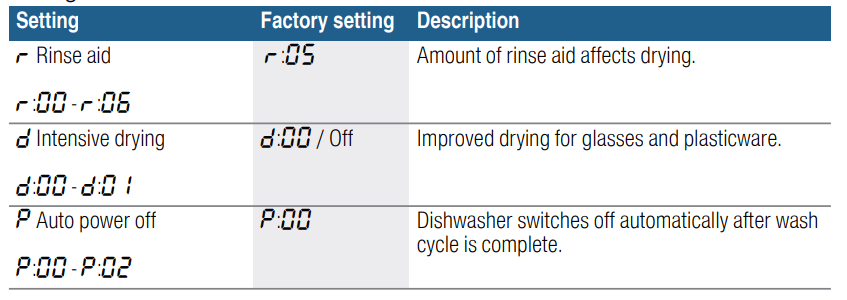
 Rinse AidS
Rinse AidS
To achieve proper drying, always use a liquid rinse aid, even if your detergent contains a rinse aid or drying additive.
Note: The dishwasher indicates low rinse aid by turning on the Rinse Aid indicator. If this indicator lights up, you need to refill the rinse aid dispenser  by following the directions below.
by following the directions below.
Adding rinse aid
NOTICE
To avoid oversudsing or clogging, do not overfill the rinse aid dispenser  . Wipe up any spills with a damp cloth.
. Wipe up any spills with a damp cloth.
- Open the rinse aid dispenser
 by pressing on the latch of the lid and pull it open.
by pressing on the latch of the lid and pull it open.

2. Add liquid rinse aid to the dispenser  until it is full. Do not overfill. Avoid spilling into air vent hole.
until it is full. Do not overfill. Avoid spilling into air vent hole.

3. Close the lid. Lid must be fully closed until it clicks in order to seal.
4. Wipe up any excess rinse aid that may have puddled when the dispenser reservoir is full.
The indicator light will go out a few moments after the dishwasher door is shut.
Tip: For easier pouring, remove lid from the rinse aid bottle.
NOTICE
Do not fill the rinse aid dispenser  with detergent. Doing so will damage the dishwasher.
with detergent. Doing so will damage the dishwasher.
Setting the amount of rinse aid used
The amount of rinse aid dispensed can be set from  to
to  . The factory setting is
. The factory setting is  .
.
You should only change the setting if streaks remain on the dishes (lower the amount), or if dishes are not getting dry enough (increase the amount).

1. Open the door.
2. Press the On/Off button  .
.
3. Hold down the function key  and press the Start button
and press the Start button  until the display
until the display  indicates
indicates  (x can be any number). Release both buttons.
(x can be any number). Release both buttons.
4. Press the function key  until the display
until the display shows
shows 
5. Press the function key  to select the desired setting.
to select the desired setting.
6. Press the Start button  to save the setting.
to save the setting.
Turning off rinse aid indicator
Proceed as described in the section “Setting the amount of rinse aid used” and set value to  . The rinse aid indicator is now turned off.
. The rinse aid indicator is now turned off.
NOTICE
Using no rinse aid or setting the dispenser to  may result in longer cycle times consuming more energy and water. The higher temperatures and longer cycle times can damage fine china or glassware.
may result in longer cycle times consuming more energy and water. The higher temperatures and longer cycle times can damage fine china or glassware.
 Loading the Dishwasher
Loading the Dishwasher
Dishware material
Note:
Before using your dishwasher for the first time, check the information in this section. Some items are not dishwasher-safe and should be hand washed; others require special loading.
Recommended
Aluminum
- Colored anodized aluminum may fade over time. Minerals in your water may cause the aluminum to darken or spot. This can usually be removed with a soap-filled steel wool pad.
China, Crystal, Stoneware
- Some hand-painted utensils may discolor, fade or spot. Hand wash these utensils. Position fragile glassware so that it will not topple over or come in contact with other utensils during the wash cycle.
Glass
- Make sure to use dishwasher-safe glass. Milk glass may discolor or become yellow.
Non-stick Coatings
- Apply a light coating of vegetable oil to non-stick surfaces after drying.
Plastics
- Make sure the plasticware is dishwasher-safe.
Stainless Steel, Sterling Silver and Silver Plates
- Load these so they do not come in contact with other metals, stainless steel dishwasher tub walls or the inner door.
Not Recommended
Acrylic
- Crazing or small cracks throughout the acrylic, may occur.
Adhesive-Joined Pieces
- Adhesives that join materials such as plastic, wood, bone, steel, copper, tin, etc. may loosen.
Bone-Handled Utensils
- Handles may separate
Iron
- Iron will rust. Hand wash and dry immediately.
Non-Dishware Items
- Your dishwasher is intended for use in cleaning ONLY standard household dishware and kitchenware.
Pewter, Brass, Bronze
- These items will tarnish. Hand wash and dry immediately.
Tin
- Tin will stain. Hand wash and dry immediately
Wood
- Wooden bowls, wooden utensils and utensils with wooden handles can crack, warp and lose their finish.
Loading the racks
For best dishwashing results, observe the following when loading the dishwasher:
- Do not pre-wash items with loosely attached food soil.
- Remove all food particles, bones, toothpicks and excessive grease.
- Pre-treat items having burned-on, baked-on or starchy soils.
- Load dishes in the dishwasher racks so the insides of bowls, pots and pans are facing the spray arms.
- Avoid nesting and contact points between dishes.
- Separate items of dissimilar metals. Use care to not block movement of the spray arms.
- Only wash household dishware and kitchenware rated as dishwasher-safe.
Refer to the Dishware Materials section for more information about dishware suitability
NOTICE
- To avoid dishwasher damage, do not load the dishwasher with paper products, plastic bags, packing materials or anything other than normal, dishwasher safe dishware and kitchenware
Loading the upper rack
Ensure items do not protrude through the bottom of the racks and block the spray arms.
Note: When pushing the upper rack into the dishwasher, push it until it stops against the back of the tub so the upper rack spray arm
into the dishwasher, push it until it stops against the back of the tub so the upper rack spray arm  connects to the water supply at the back of the tub. Do not push racks in using the door.
connects to the water supply at the back of the tub. Do not push racks in using the door.
Loading the lower rack
- Place large items in the lower rack
 . Load pots, pans and bowls upside down. Do not block the vent hole
. Load pots, pans and bowls upside down. Do not block the vent hole  with tall baking sheets.
with tall baking sheets. - Load these items on the right side of the dishwasher.
Loading patterns for lower rack
12 place setting suggested loading pattern
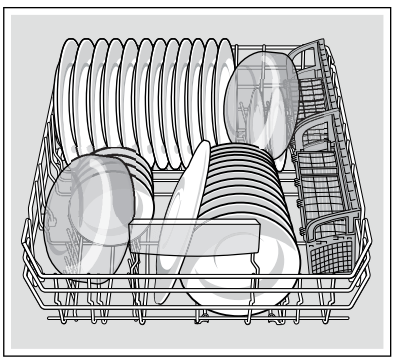
Alternate loading pattern
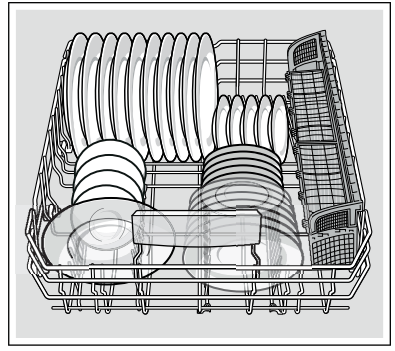
Alternate loading pattern with pots and pans
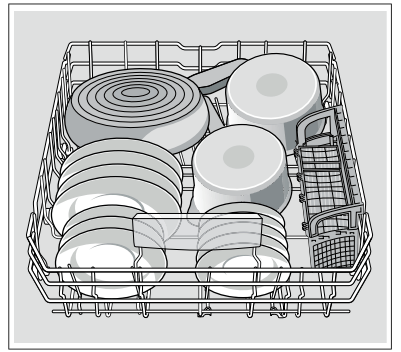
For best results, load large items face down in the lower rack.
Loading patterns for upper rack
12 place setting suggested loading pattern, with third rack cutlery drawer *

Alternate loading pattern
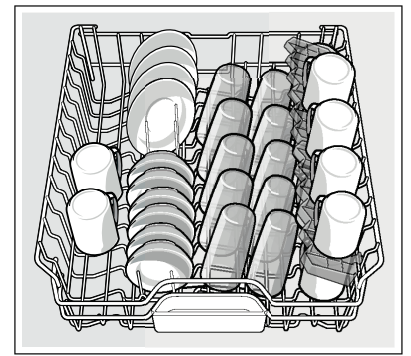
Alternate loading pattern with stemware
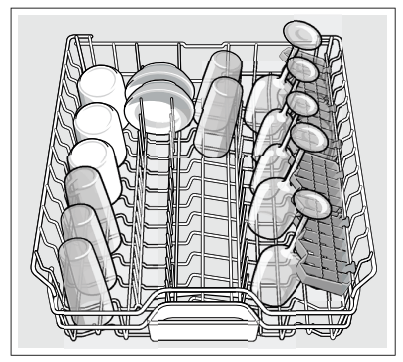
Use supports to load stemware glasses in the upper rack.
Loading patterns for third rack*
12 place setting suggested loading pattern
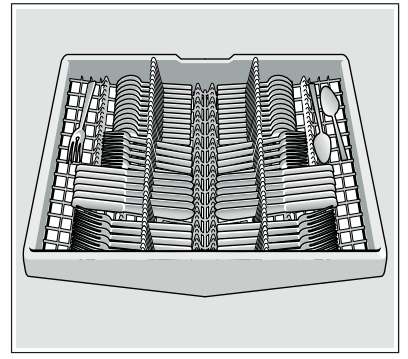

Loading the silverware basket
Place knives and sharp utensils with their handles up and forks and spoons with their handles down. If large or oddly-shaped items are loaded in the silverware basket, be sure they do not nest together.
 WARNING
WARNING
RISK OF INJURY!
The sharp points and edges of knives and other sharp utensils can cause serious injury. Load knives and other sharp utensils with edges down. Do not allow children to handle or play near knives and sharp utensils.
Long silverware basket*
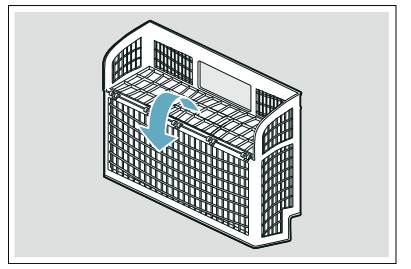
Note: The silverware basket lid may also be folded downward in order to leave the basket open.
* optional feature which may or may not be included with your dishwasher.
The Double Flex silverware basket *
This basket splits along its length, resulting in two halves that may be placed in a variety of positions in the lower rack  , greatly increasing the lower rack’s loading versatility. The basket snaps together either side by side or back to back.
, greatly increasing the lower rack’s loading versatility. The basket snaps together either side by side or back to back.
To split the Double Flex silverware basket:
Grasp the basket and slide the two halves in opposite directions and then pull the two halves apart.
Side by side

Back to back
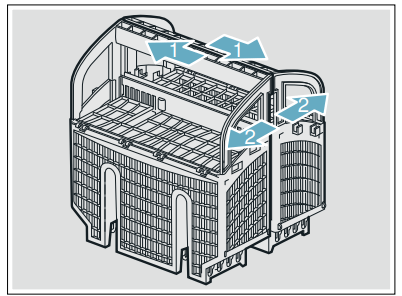
To assemble the Double Flex silverware basket:
Hold the two halves side by side or back to back, so that the tab on one basket can slip into the notch on the other basket. Push the two halves in opposite directions until they click.
Note: The silverware basket lid may also be folded downward in order to leave the basket open.
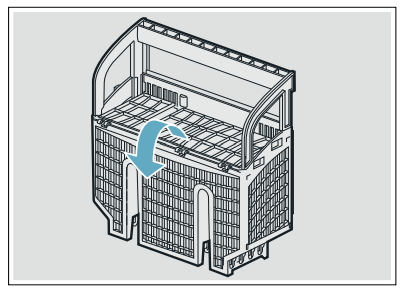
* optional feature which may or may not be included with your dishwasher.
Suggested loading patterns

- Salad fork
- Teaspoon
- Dinner fork
- Knife
- Tablespoon
- Serving spoon
- Serving fork
Silverware basket
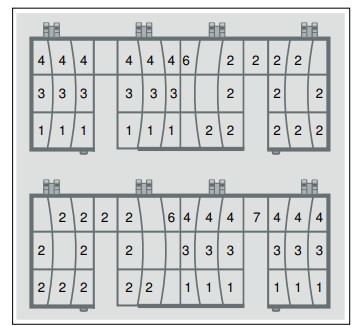
Double Flex silverware basket
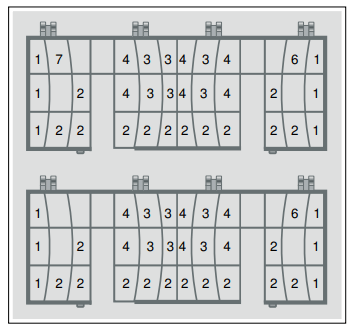
Unloading the dishwasher
CAUTION
Dishes can be very hot immediately after cycle ends. Open the door slightly and allow dishes to cool for a few minutes before unloading.
Note: Dishes are more likely to chip when unloading before cooling.
When unloading the dishwasher, to prevent water from dripping onto dry dishes, unload the lower rack  first. Next, unload the silverware basket
first. Next, unload the silverware basket  followed by the upper rack
followed by the upper rack  , and then the third rack (if equipped).
, and then the third rack (if equipped).
Adjusting the height of the rack
If desired, the height of the upper rack  can be adjusted to create more space for taller utensils either in the upper or lower rack.
can be adjusted to create more space for taller utensils either in the upper or lower rack.
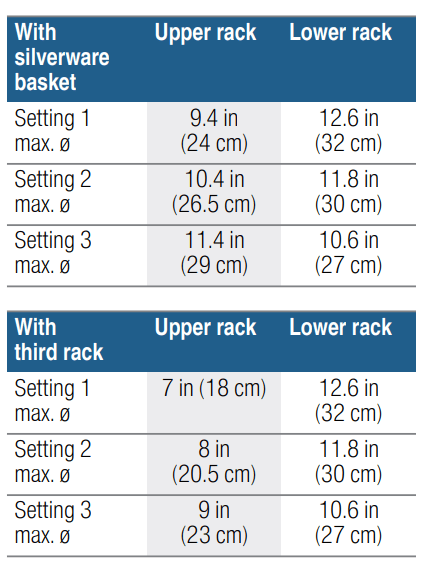
Arrange large plates up to a diameter of 12.6 in (32 cm) in the lower basket  as illustrated.
as illustrated.
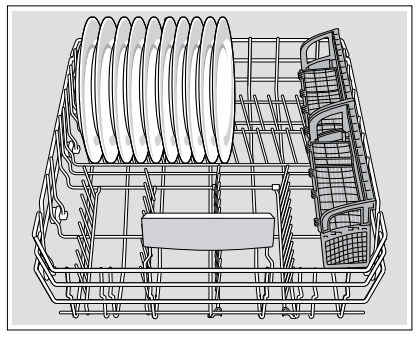
RackMatic®
The height of the upper rack  can be adjusted in 3 steps to create more space.
can be adjusted in 3 steps to create more space.
Pull the upper rack out of the dishwasher until it stops.
- To lower the rack, push the
- RackMatic® lever inward.
- To raise the rack, hold the basket on the sides of the upper rack and lift it up.
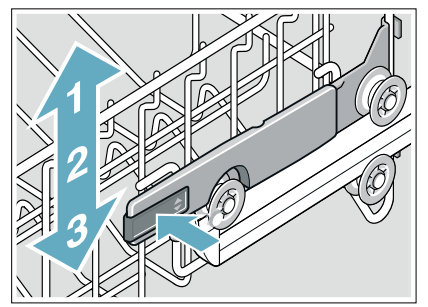
Note: Check spray arm for clearance after adjustment.
Rack accessories
Flip tines
The upper and lower rack are fitted with flip tines that can be folded down depending on what you may need to load in the rack.
Lower rack flip tines: To fold down, pull flip tine gently forward and release it from the notch. Push the flip tine downward. To fold up, push flip tines into an upright position until the holder engages in the notch.
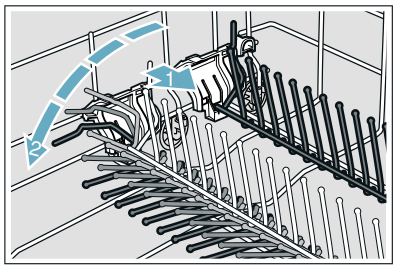
Upper rack flip tines: To fold down, push flip tines downward with gentle pressure. To fold up, push flip tines into an upright position until the holder engages in the notch.

Third rack
The third rack  horizontally positions knives, spatulas and other oversized tools for improved cleaning and easier loading and unloading. Arrange cutlery in third rack as illustrated.
horizontally positions knives, spatulas and other oversized tools for improved cleaning and easier loading and unloading. Arrange cutlery in third rack as illustrated.
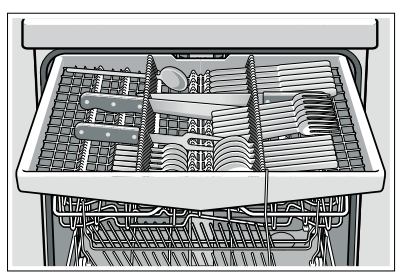
You can fold down the side shelves to provide more room for taller items of silverware.* The front rows of prongs can be folded down to provide room for wider handles.

* optional feature which may or may not be included with your dishwasher..
Cup shelves
The cup shelves and the space underneath them can be used for small cups or for larger serving utensils. They also serve as stemware supports.→ "Loading patterns for upper rack" on page 19
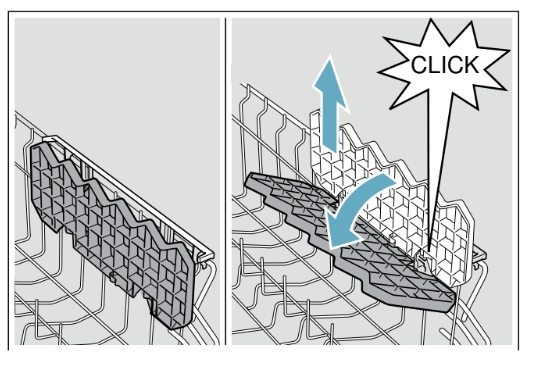
* optional feature which may or may not be included with your dishwasher..
Plastic item clips*
Light-weight plastic accessories (cups, lids, etc.) can be held securely by the plastic item clips. Press the plastic item clip against the upper rack  as shown until it clicks.
as shown until it clicks.
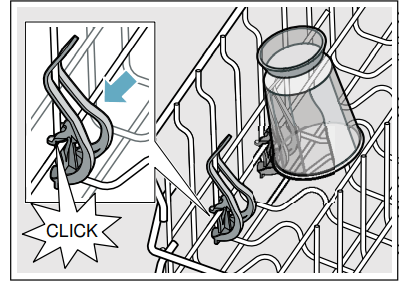
Extra tall item sprinkler*
If an item is too tall to be placed in the lower rack  even with the upper rack
even with the upper rack in the raised position, remove the empty upper rack
in the raised position, remove the empty upper rack  by pulling it out of the dishwasher until it stops. Pull the front of the rack upward and outward until the rack will not slide out anymore. Then lift it up and away from the dishwasher, until the rollers are completely free of the roller guides (A).
by pulling it out of the dishwasher until it stops. Pull the front of the rack upward and outward until the rack will not slide out anymore. Then lift it up and away from the dishwasher, until the rollers are completely free of the roller guides (A).
Set the upper rack  aside and push the roller guides (A) back into the dishwasher. Insert the extra tall item sprinkler (B) into the upper rack spray outlet (C) and turn the sprinkler clockwise to lock into position.
aside and push the roller guides (A) back into the dishwasher. Insert the extra tall item sprinkler (B) into the upper rack spray outlet (C) and turn the sprinkler clockwise to lock into position.
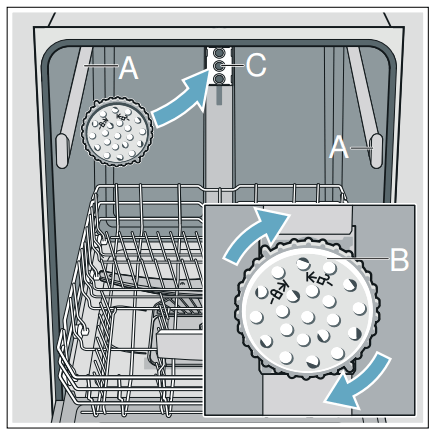
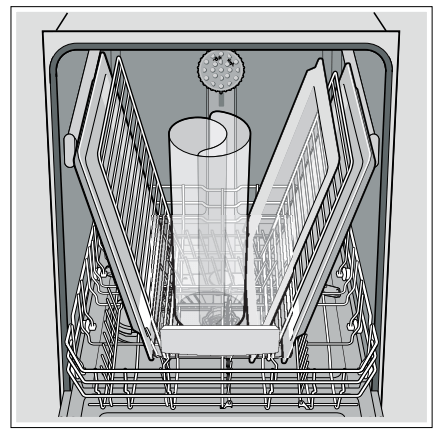
Note: Keep the vent hole  on the tub’s left side clear by placing tall items such as plastic cutting boards and tall baking sheets on the lower rack’s right side or center.
on the tub’s left side clear by placing tall items such as plastic cutting boards and tall baking sheets on the lower rack’s right side or center.
NOTICE
To avoid dishwasher damage, do not reinstall the upper rack  without removing the extra tall item sprinkler (B).
without removing the extra tall item sprinkler (B).
* optional feature which may or may not be included with your dishwasher.
Removing/Installing third rack
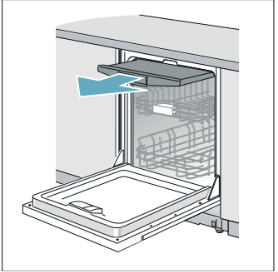
Removing third rack 
- Pull out third rack all the way (1).
- Lift upper rollers over the stopper hooks of both rails (2).
- Pull third rack out forward and upward so that the holding hooks and the lower rollers of the rack slide over the stopper hooks of both rails (3).
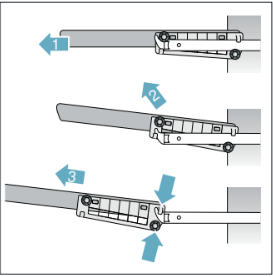
Installing third rack 
- Pull out third rack rails all the way (1).
- Insert third rack at an angle. Make sure that the stopper hooks of both rails slide in between the holding hooks and the lower rollers of the third rack (2).
- Slide third rack in and lift the upper rollers over the front stopper hooks of both rails (3).
- Push in third rack (4).
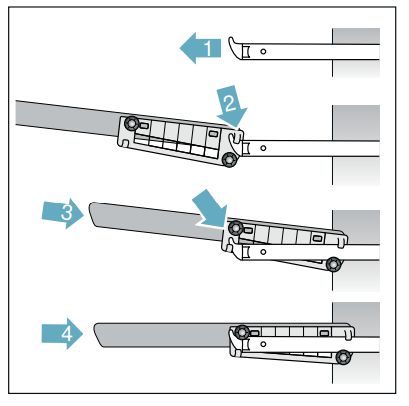
Removing/Installing upper rack with Rackmatic®

Removing upper rack 
- Pull out upper rack all the way (1).
- Lift front rollers over the stopper hook of the rail (2).
- Pull out upper rack forwards and upwards so that the upper and lower rollers of the rack slide over the stopper hooks of both rails (3).
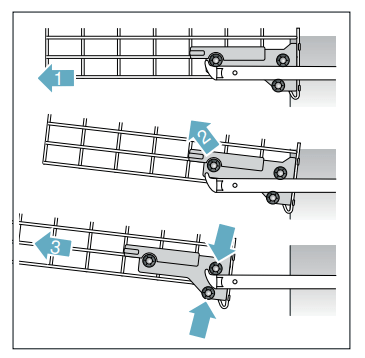
Installing upper rack 
- Pull out upper rack rails all the way (1).
- Insert upper rack at an angle.
- Make sure that the stopper hooks of both rails slide in between the upper and lower rollers on the rear side of the rack (2).
- Slide upper rack in and lift the upper rollers over the front stopper hooks of both rails (3).
- Push in upper rack (4).
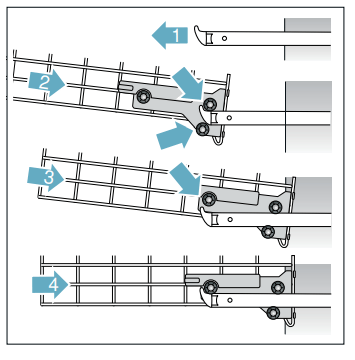
 Detergent
Detergent
Use only detergent specifically designed for dishwashers. For best results, use fresh powdered dishwashing detergent or detergent tabs.
NOTICE
To avoid damage to dishwasher or dishware:
- Do not use hand dishwashing products in your dishwasher.
- Do not use too much detergent if your water is soft. Using too much detergent with soft water may cause etching in glassware and fine china.
- To best protect glassware, use a wash cycle with low temperatures or a specific glass-care cycle depending on the model) and use a detergent that includes etch protection.
This dishwasher uses less water than most, therefore, less detergent is required. With soft water, tablespoon (15 ml) of detergent will clean most loads. The detergent dispenser cup has lines that measure detergent to 1 tablespoon (15 ml) and 1.75 tablespoons (25 ml). tablespoons (45 ml) of detergent will completely fill the detergent dispenser.
Note: If you do not know the hardness of your water supply, use 15 ml of detergent. Increase the amount if necessary to the least amount required to get your kitchenware clean.
Use the measuring lines in the detergent dispenser cup as a guide to measure the amount of detergent recommended in the following table.
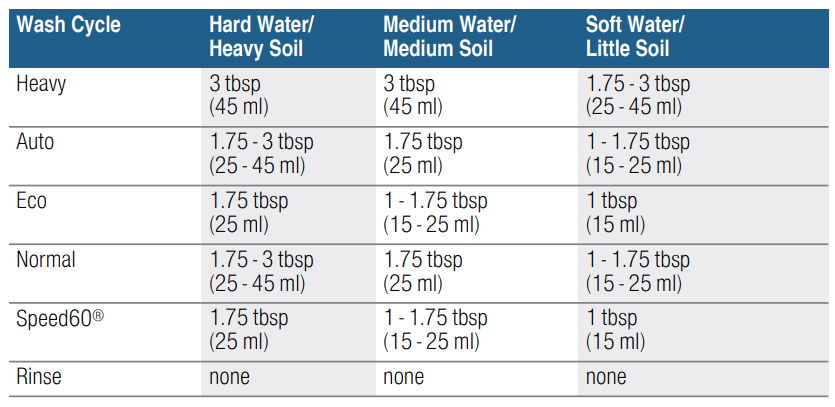
Adding detergent
1. If the detergent dispenser  is still closed, push the button
is still closed, push the button  to open it.
to open it.
Note: Make sure the detergent dispenser is dry and clear of detergent residue.
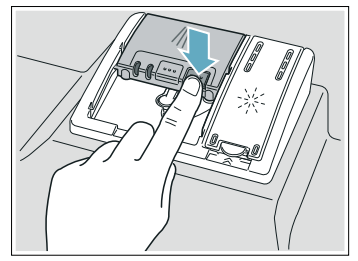
2. When using detergent tabs, lay them such that they do not come in contact with the cover, insert a detergent tab flat, not on its side.
Note: Do not place detergent tabs or utensils in the detergent tab tray  . Place tabs or other detergent forms directly in the detergent dispenser
. Place tabs or other detergent forms directly in the detergent dispenser  .
.
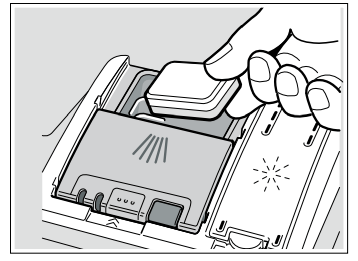
Pour detergent into the dry detergent dispenser  only. Add detergent. Do not overfill the detergent dispenser.
only. Add detergent. Do not overfill the detergent dispenser.

Dosage: see manufacturer’s instructions on the packaging.
3. Close the lid by placing the finger on the lid as shown. Slide the lid closed until it clicks.

The detergent dispenser will open automatically at the ideal time for the set cycle. The powder or liquid detergent is distributed in the appliance and is dissolved, detergent tabs will fall into the detergent tab tray  where it dissolves during the cycle.
where it dissolves during the cycle.
Tip: If the dishware is only lightly soiled, slightly less than the indicated amount of detergent is usually adequate.
 Dishwasher Cycles
Dishwasher Cycles
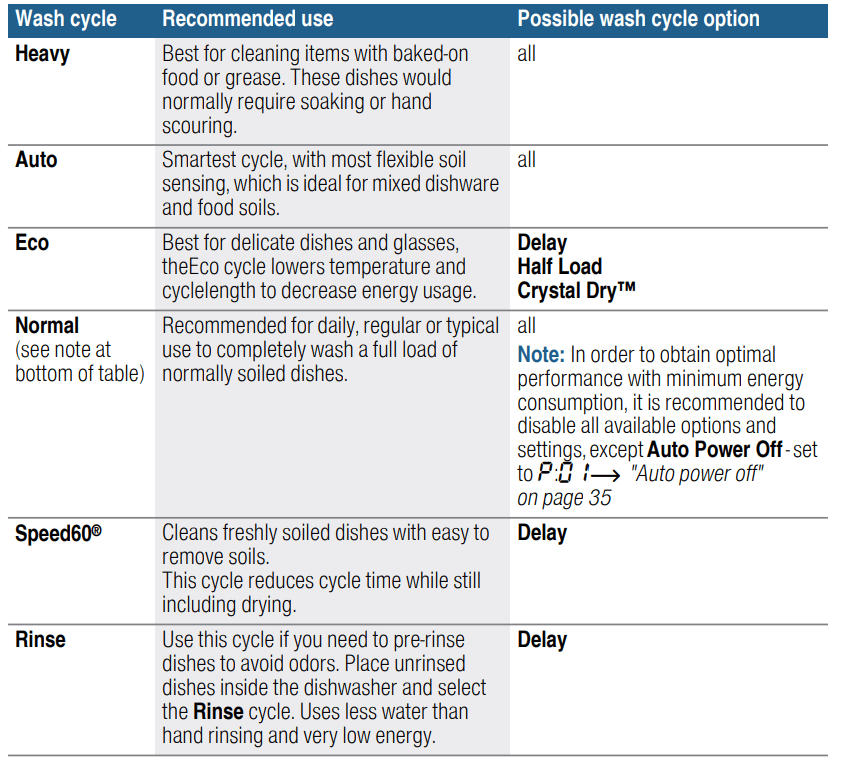
Note: The Energy Guide label was based on the Normal soil sensing cycle as follows: The unit was tested without any rinse aid (liquid) in the rinse aid dispenser  . A single dose of detergent was inserted into the detergent dispenser
. A single dose of detergent was inserted into the detergent dispenser , with no detergent being used in the prewash. The unit was not subjected to truncated testing per the definitions in the test procedure. We recommend that dish loads such as the one in the energy certification test have the rack position set in the highest position.
, with no detergent being used in the prewash. The unit was not subjected to truncated testing per the definitions in the test procedure. We recommend that dish loads such as the one in the energy certification test have the rack position set in the highest position.
Note: Some of the wash cycles and options will vary by model.
 Dishwasher Cycle Options
Dishwasher Cycle Options
Delay
- Allows you to delay the start time of your dishwasher up to 24 hours.
Half Load
- Can reduce water consumption when washing small, lightly soiled loads that fill approximately half or less of the dishwasher’s capacity
Delicate
- This option’s reduced time and temperature are best for lightly soiled items with easy to remove food soils. The option also reduces the likelihood of cloudy glasses. Rinse aid is recommended for the high gloss drying function (even when using combination detergents).
Sanitize
- Increases the temperatures and retains them for an extra long time to obtain a defined disinfecting performance. Continuous use of this function increases the hygiene status. This additional option is ideal for cleaning items such as chopping boards and baby bottles.
- “Sanitized” will appear in the display window when sanitation requirements are met. Using the Sanitize option may also improve drying. There is a slight increase in energy consumption.
CrystalDry™
- Patented CrystalDry™ technology thoroughly dries dishes and plastics such as baby bottles and food storage containers. Natural minerals transform moisture into heat up to 176F to get dishes, even plastics 60% drier.*
- * Based on aggregate average drying performance of Bosch Dishwashers with CrystalDry™ on combined household load including plastics, glass, steel, and porcelain as compared to Bosch Dishwashers with PureDry. Drying performance may vary by dish type.
ExtraScrub® *
- This option increases pressure and temperature in the lower rack for intensive cleaning.
Wash Cycle Information
To save energy, this dishwasher has EcoSense where the sensors in the dishwasher automatically adjust the cycle length, temperature and water changes based on the amount of food soil and the incoming water temperature. The “Smart Control” makes decisions that can cause the cycle time and water usage to adjust intermittently. Wash cycle times are based on 120°F (49° C) water supply. If your household water supply is different than 120°F (49° C), your dishwasher’s cycle times may be impacted.
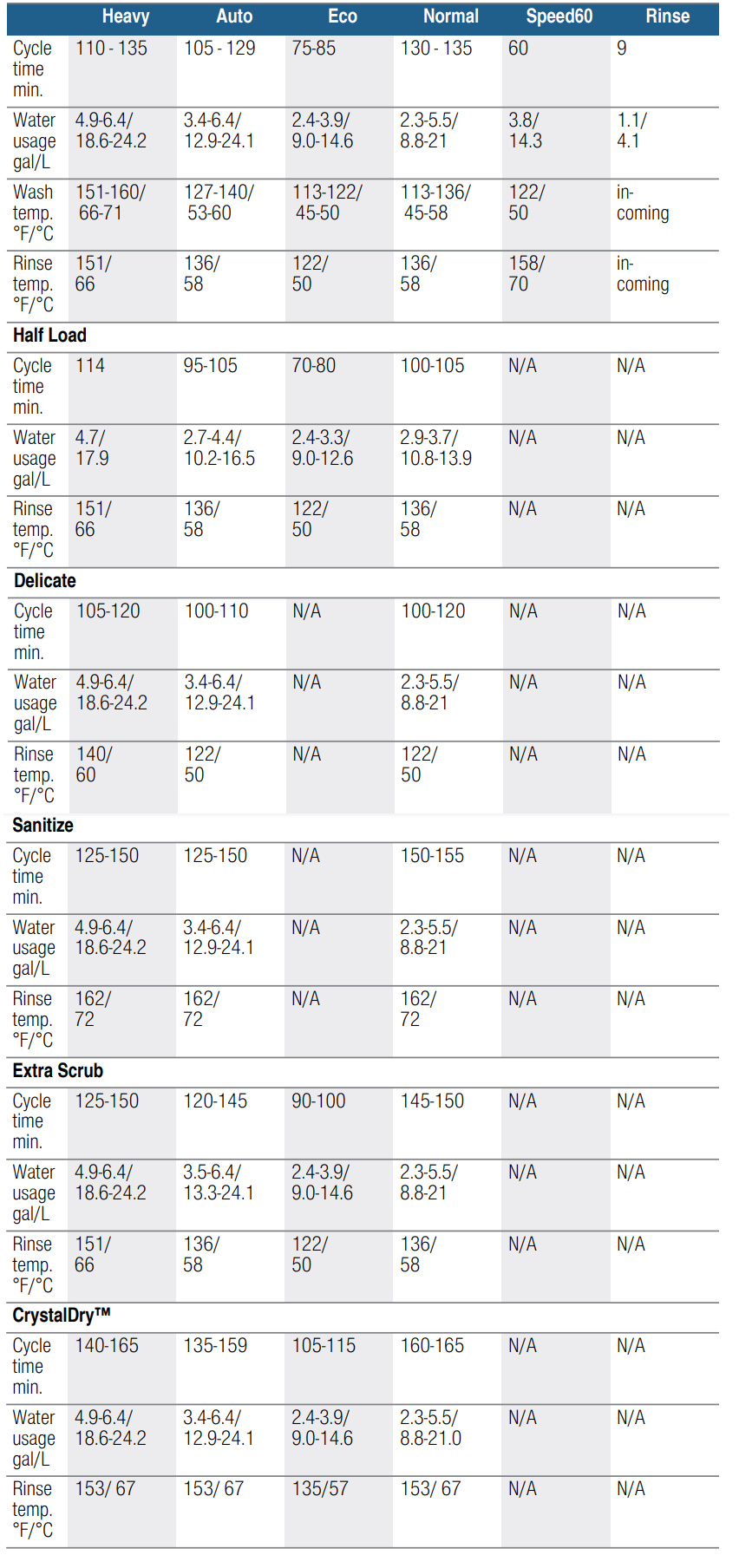
Note: Only sanitizing cycles have been designed to meet the requirements of Section 6 of the NSF/ANSI Standard for Residential Equipment for soil removal and sanitization efficacy. There is no intention, either directly or indirectly, to imply that all cycles have passed sanitization performance tests.
 Operating the Dishwasher
Operating the Dishwasher
Note: With hidden controls, the door must be opened before changing settings and closed after changing settings.
WARNING
RISK OF INJURY! To avoid risk of injury, always use caution when opening the door during or following a wash cycle as hot water or steam may escape. Do not fully open the door until water noises have stopped and steam has subsided.
Protection against unintentional operation
Your dishwasher is equipped with a function that helps to prevent unintentional operation (e.g. by children).
After starting the dishwasher, the dishwasher door has to be closed within 4 seconds, otherwise the operation will be paused. There will be a signal on the control panel advising you to press the Start button again and close the door.
This function will be activated when:
- Pressing Start to begin a wash cycle
- Setting Delay time and pressing Start
- Opening the door while Delay time is active
- Opening the door during a wash cycle.
Note: This function cannot be deactivated.
Operating the touch buttons
Buttons are sensitive and should be touched gently. Avoid any grease or food particles resting on the buttons as they could activate the dishwasher.
Wiping and cleaning can also activate the dishwasher. For best results, use bare, clean hands when touching the buttons.
To clean the touch buttons wipe them with a dry or slightly damp cloth
AquaSensor
- The AquaSensor is an optical measuring device which measures the cleanliness of the rinse water.
- The AquaSensor is used according to the wash cycle. If the AquaSensor is active, “clean” rinse water can be transferred to the next rinse and water consumption can be reduced by 0.8–1-5 gal (3–6 liters). If the rinse water is not yet clear, the water is drained and is replaced with fresh water. In the automatic wash cycles the temperature and running time can also be adjusted to the degree of soiling.
Switching the appliance on
- Turn the water supply on fully.
- Open the door.
- Press the On/Off button
 . The display of the last selected wash cycle flashes. This wash cycle remains selected if no other wash cycle button
. The display of the last selected wash cycle flashes. This wash cycle remains selected if no other wash cycle button  is pressed. Select any desired option.
is pressed. Select any desired option. - Press Start button
 . Wash cycle sequence starts.
. Wash cycle sequence starts.
Note: YYour dishwasher is protected against unintentional operation. If the appliance door remains open for more than 4 seconds after pressing the Start button, the operation will be paused. Close the appliance door and press the Start button  again.
again.
Time display
When a wash cycle is selected the remaining wash cycle time is shown on the display  . The wash cycle time is determined during the wash cycle by the water temperature, the amount of dishes, as well as the degree of soiling and may vary (depending on the selected wash cycle).
. The wash cycle time is determined during the wash cycle by the water temperature, the amount of dishes, as well as the degree of soiling and may vary (depending on the selected wash cycle).
Delay Start
You can delay the start of the cycle in one hour increments up to 24 hours.
 1 hour delay
1 hour delay
 24 hours delay
24 hours delay
To set Delay start:
- Open the door and press the On/Off button
 . Select a cycle.
. Select a cycle. - Press the Delay button
 until the displayed time corresponds with your requirements.
until the displayed time corresponds with your requirements. - Press the Start button
 to activate Delay start.
to activate Delay start.
To cancel Delay start:
- Open the door and press the Delay button until h:00 is indicated on the digital display
 .
. - Press the Start button
 to save setting.
to save setting.
Note: Your dishwasher is protected against unintentional operation. If the appliance door remains open for more than 4 seconds after pressing the Start button, the operation will be paused. Press the Start button again and close the appliance door.
Wash cycle end
The wash cycle has ended when the display  reads
reads  .
.
Auto power off
This setting determines the length of time the control panel stays illuminated after the cycle is complete. To save energy the recommended setting is
This setting can be adjusted from to
to
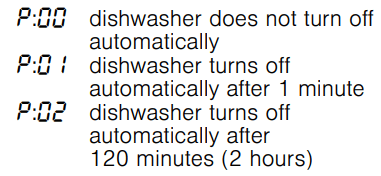
To change the setting:
- Press the On/Off button

- Hold down the function key
 and press the Start button
and press the Start button  until the display
until the display  indicates
indicates  (x can be any number).
(x can be any number). - Release both buttons.
- Press the function key
 until the display
until the display indicates
indicates 
- Press the function key
 until the display corresponds with your requirements.
until the display corresponds with your requirements. - Press the Start button

Switching off the appliance
Short time after the end of the wash cycle:
- Press On/Off button

- Remove the dishes when they have cooled down.
 WARNING
WARNING
RISK OF INJURY!
To avoid risk of injury, always use caution when opening the door during or following a wash cycle as hot water or steam may escape. Do not fully open the door until water noises have stopped and steam has subsided.
Interrupting the wash cycle
CAUTION
Expansion (overpressure) may cause the appliance door to open and/or water to escape! If the door was opened on an appliance which has a hot water connection or is heated, always leave the door ajar for several minutes and then close.
- Open the door.
- Switch off On/Off switch
 The LED’s go out. The wash cycle is saved.
The LED’s go out. The wash cycle is saved. - To continue the wash cycle, switch on the On/Off switch
 again.
again. - Close the door.
Note: Your dishwasher is protected against unintentional operation. If the appliance door remains open for more than 4 seconds after pressing the Start button, the operation will be paused. Press the Start button again and close the appliance door.
Terminating the wash cycle (Reset)
- Press and hold Start button
 for approximately 3 seconds until the display reads
for approximately 3 seconds until the display reads .
. - Wait about 1 minute while the dishwasher drains.
- Press On/Off button
 .
.
You may now power the dishwasher back on and begin a new cycle if desired.
Changing the wash cycle
When the Start button  ( has been pressed, the wash cycle cannot be changed. The only way a wash cycle can be changed is by terminating the wash cycle (Reset).
( has been pressed, the wash cycle cannot be changed. The only way a wash cycle can be changed is by terminating the wash cycle (Reset).
Intensive drying
The final rinse uses a higher temperature which improves the drying result. The cycle time may increase slightly. (Caution if utensils are delicate!)
This feature has two settings:
 Off
Off
 On
On
- Open the door.
- Press the On/Off button
 .
. - Hold down function key
 and press Start button
and press Start button  until the display
until the display  indicates d:x (x can be any number).
indicates d:x (x can be any number). - Release both buttons.
- Press function key
 until the display
until the display  indicates the factory set value
indicates the factory set value  .
. - Press function key
 to switch the Extra dry feature on
to switch the Extra dry feature on  ‚ or off
‚ or off  .
. - Press Start button
 to save setting.
to save setting.
 Care and Maintenance
Care and Maintenance
Care and Mai nt enanceA regular inspection and maintenance of your machine will help to prevent faults. This saves time and prevents future problems.
Cleaning the dishwasher
- Regularly wipe the front of the appliance with a damp cloth - water and a small amount of liquid soap is adequate.
- For black stainless steel and anti-fingerprint surfaces, use a soft, dry towel. For stubborn dirt, use warm water diluted with a non-abrasive, mild cleansing soap. Never use stainless steel polish.
- For stainless steel appliances (excluding black stainless and anti-fingerprint), use a stainless steel polish to seal and protect the surface.
- Clean the outer edges of the inside door panel regularly to remove debris that may collect from normal loading. If spots begin to appear on the stainless steel, make sure the rinse aid dispenser is full and functioning properly.
- Clean the door seal regularly with a damp cloth to remove food particles that may collect from normal loading and cause odor. A soiled door seal may not seal properly.
NOTICE
- Never use a steam cleaner to clean your dishwasher. The manufacturer is not liable for any resulting damage.
- Do not use sponges as they could scratch the surfaces.
- Do not use bleach-based wipes as they could damage the surface or printing.
- Never use stainless steel polish on a black stainless finish or anti-fingerprint surfaces.
WARNING
RISK OF EXPLOSION!
■ When cleaning your dishwasher with any cleaning agent, remove all cookware, utensils or any foreign material from inside. Some cleaning agents are highly acidic and/or caustic alkaline, which can cause hydrogen gas to form if aluminum material is also inside the dishwasher tub. Hydrogen gas is explosive.
WARNING
Use caution when removing parts for cleaning as some debris may be sharp.
Filters
- The Bosch® filter system
 is designed to prevent the need to pre-rinse normally attached food soils from your dishes. Simply scrape leftover food soils off of dishware before loading. This process will conserve time, water and the energy require to heat your household water supply.
is designed to prevent the need to pre-rinse normally attached food soils from your dishes. Simply scrape leftover food soils off of dishware before loading. This process will conserve time, water and the energy require to heat your household water supply. - Your dishwasher filter system is designed to filter 100% of the water entering the spray arms to provide a continuous supply of clean water to remove food soils from your dishware.
Filter components
The filter system  consists of three parts.
consists of three parts.
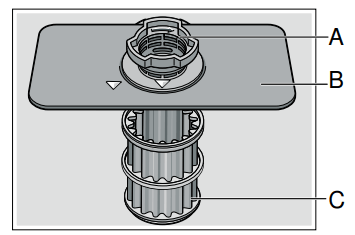
A Large Object Trap
- Prevents objects that should not be placed in your dishwasher from damaging the dishwasher pump system or clogging your household drain.
B Flat Fine Filter
- Prevents food particles from entering the wash chamber and directs particles toward the micro filter
C Micro Filter
- Directs the smallest of particles to the household plumbing drain.
Cleaning intervals
The filter system  is designed to minimize maintenance while providing premium cleaning performance and minimum energy consumption.
is designed to minimize maintenance while providing premium cleaning performance and minimum energy consumption.
Depending on use habits and water hardness, the filter system will require some maintenance to sustain premium cleaning performance.
Your filter system may need to be cleaned when:
- You notice food soils remaining on the filter system or objects trapped in the Large Object Trap.
- A drop in cleaning performance or a gritty film forms on the dishware.
When washing normally attached food soils that have been scraped before loading, in a household that runs the dishwasher every other day, your filter should be cleaned:

Note: Clean the filter after washing loads with large amounts of food soils or loads with a heavy starch content, like potatoes and pasta, to maintain optimal performance.
To check or clean the filter system:
- Unscrew the Large Object Trap as illustrated and remove the entire filter system.
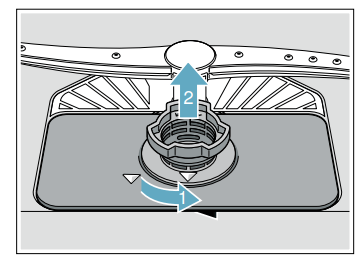
- Remove the microfilter from the fine filter for easier cleaning.
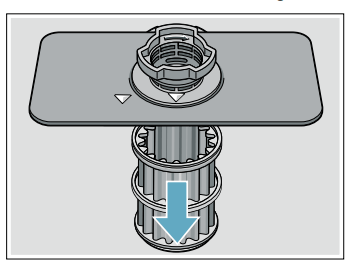
- Rinse the filters under running water and use a soft brush to clean.
Note: do not use abrasive brushes or steel wool, etc., as they may damage the filter. - Reinstall the filter system in reverse sequence and lock into place by screwing the Large Object Trap until the marking arrows align.
Spray arms
Check spray arms  ,
,  for grease and limescale deposits. If you find such deposits:
for grease and limescale deposits. If you find such deposits:
- Fill detergent dispenser
 with detergent and start the appliance without utensils in the cycle with the highest rinsing temperature.→ "Wash Cycle Information" on page 31
with detergent and start the appliance without utensils in the cycle with the highest rinsing temperature.→ "Wash Cycle Information" on page 31 - Clean the appliance with detergents/appliance cleaners which are particularly suitable for use with dishwashers.
- Unscrew the upper spray arm
 and pull off the lower spray
and pull off the lower spray  arm as shown. Inspect for deposits.
arm as shown. Inspect for deposits.
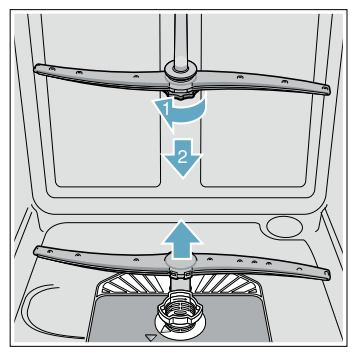
Drain pump
Large food remnants in the rinsing water not retained by the filters may block the waste water pump. In this case:
- Disconnect the appliance from the power supply.
- Remove the filters.→ "Filters" on page 39
- Scoop out standing water - use a sponge if necessary.
- Using a spoon, pry off the pump cover until it clicks, then grip the cover and pull upward until it resists and then pull forward.
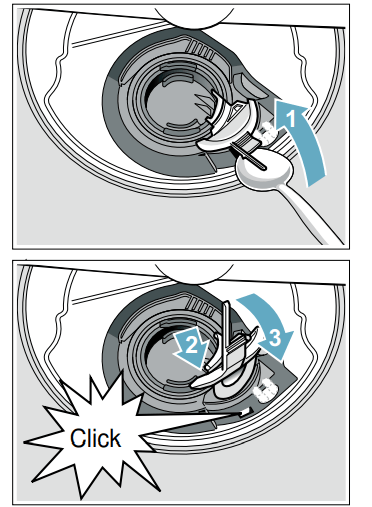
- Check inner compartment and remove any foreign objects.
WARNING Use caution when removing parts for cleaning as some debris may be sharp.
- Place cover in the original position, press down and engage.
- Reinstall filters.
Note: The drain pump will not work properly if the drain pump cover is not snapped in completely until it clicks.
Preparing your unit for vacation
NOTICE
Before leaving for vacation during warmer weather, besides turning off the main valve, also turn off water supply at the nearest point to the dishwasher. Do not leave soiled dishware in unit and leave door slightly open. During colder weather, please follow the instructions for winterizing your unit below.
Winterizing your unit
NOTICE
If your dishwasher will be unused for a period of time in a location that experiences freezing temperatures (holiday home or through a vacation period), have your dishwasher winterized by a professional service.
 Troubleshooting
Troubleshooting
Dishwashers may occasionally exhibit problems that are unrelated to a malfunction of the dishwasher itself. The following information may help you with a dishwasher problem without involving a repair professional. Turn off tap.
Call customer service and quote the fault code.
Problem | Cause | Action |
Error code  is lit. is lit. | Supply hose kinked. | Install supply hose without kinks. |
| Water supply turned off. | Turn on the water supply. | |
| Water supply line is clogged. | Unclog water line. | |
Error code  is lit. is lit. | Water in sump since sump filters  are dirty or blocked. are dirty or blocked. | Clean filters. |
Error code  is lit. is lit. | Drain line is clogged. | Unclog drain line. |
| Drain hose is kinked, clogged or blocked. | Replace drain hose. | |
| Drain pump impeller (vanes) is clogged or blocked. | Remove drain pump cover, clean around pump impeller and replace cover. | |
| Drain pump cover was loose. | Lock drain pump cover into place in the sump. | |
Error code  is lit. is lit. | Drain pump is blocked or pump cover is loose. | Clean drain pump and lock drain pump cover into place in the sump. |
Error code  is lit. is lit. | Supply voltage too low (less than 98 volts). | Not a dishwasher fault; have the supply voltage and electrical installation checked. |
A different error code is indicated on the digital display. ( to to  ) ) | A technical fault has probably occurred. | Switch off dishwasher with the On/Off switch If the problem recurs, turn off the tap and pull out the power supply plug. Call customer service and mention the error code. |
| Dishwasher does not start. | Door may be ajar or not be properly latched. | Close door securely until door latch clicks. |
| No power to the dishwasher (display won’t come on). Fuse may have been blown, circuit breaker may have tripped, power cord may have been unplugged or dishwasher may have been turned off. | Replace blown fuse or reset tripped circuit breaker. Plug power cord into outlet securely. Press the on/off button  to turn the dishwasher on. to turn the dishwasher on. | |
| Can’t select a wash cycle since the previous wash cycle may not have finished or the dishwasher hasn’t been reset. | Reset the dishwasher by pressing and holding the START button for at least three seconds. | |
| Delay start or Child lock may be activated. | Reset Delay start or Child lock functions (refer to the appropriate section in this manual). | |
| The door may have been closed without selecting a wash cycle. | Select a wash cycle and close the door. | |
| Water supply may not be turned on or connected. | Check and turn on water supply. | |
| Wash cycle won’t resume after door was opened and closed. | The door has been open for more than 4 seconds after pressing the Start button. | Press Start button again and close the dishwasher door within 4 seconds (see "Protection against unintentional operation" section in this manual). |
| Wash cycle abruptly stops. | Door may be ajar or not properly latched. | Close door securely until door latch clicks. |
| Objects placed into the upper rack handle tray prevented the door from being closed securely. | Remove objects from upper rack handle tray and close door securely until door latch clicks. | |
| Power and/or water supply interrupted. | Restore power and/or water supply. | |
| Dishwasher runs a long time. | Incoming water is not warm enough. | Before starting a cycle, run hot water faucet at the sink closest to the dishwasher. |
| Cycle time depends on wash cycle chosen and amount of soil on dishes (dishwasher sensors increase cycle times to ensure dishes are clean when heavy soil is detected). | Scrape food off of dishes and use less intensive wash cycles. | |
Rinse aid dispenser  is empty, or rinse aid setting = 0. Without rinse aid, wash cycle defaults to longest time with most number of washes and rinses. is empty, or rinse aid setting = 0. Without rinse aid, wash cycle defaults to longest time with most number of washes and rinses. | Add rinse aid and change rinse aid setting depending on water hardness. | |
| Dishwasher is connected to cold water supply. | Connect dishwasher to hot water supply. | |
| Dishes aren’t clean enough | Spray arms are blocked or misaligned where they cannot rotate freely. | Make sure spray arms  can rotate freely. can rotate freely. |
| Little or no water spray due to clogged spray arm nozzle. | Clean out spray arm nozzles and filters of all debris and obstructions. → "Spray arms" on page 40 | |
Little or no water spray due to clogged or misaligned filters  | Clean filters and make sure they’re installed correctly. → "Filter components" on page 39 | |
| Dishes are nested or placed too closely together and racks are overfilled. | Space dishes apart so spray jets can reach the surface of the dishes and dishes don’t contact each other. → "Loading the Dishwasher" on page 17 | |
| Improper or ineffective wash cycle or detergent used. | Choose a more intensive wash cycle and use appropriate dishwasher detergents. → "Wash Cycle Information" on page 32 | |
| Detergent is made less effective due to hard water. | Install a water softener and choose a more intensive wash cycle. | |
| Removable spots or streaks on glasses and silverware. | Too much rinse aid causes streaks and too little rinse aid can cause spots. | Add rinse aid and check rinse aid setting (recommended setting 4-5). → "Rinse Aid" on page 15 |
| Mineral deposits from hard water. | Install a water softener. | |
| Water from top (3rd) or upper rack dripped on racks below. | Unload lower rack 1st, upper rack 2nd and top (3rd) rack last. | |
| Dishes not dry. | Rinse aid dispenser  is empty or incorrect rinse aid amount is set. is empty or incorrect rinse aid amount is set. | Add rinse aid or adjust setting - the use of rinse agent improves drying, use the Auto cycle, use the Sanitize option. |
| Extra Dry heat option not chosen.* | Activate Extra Dry heat option.* | |
| Water collected in depressions on the dishes and silverware. | Arrange dishes in upper rack to slope so water can drain. | |
| Door was opened or dishes removed before wash cycle was completed. | Wait until wash cycle ends before opening door or removing dishes. | |
| Plastics don’t absorb heat like cutlery or china and don’t dry as well. | Use more intensive wash cycles (with hotter rinse water) or activate Extra Dry heat option.* | |
| Silverware not arranged properly in the silverware basket or top rack. | Arrange silverware properly and separate them so they don’t contact each other. | |
| Refill indicator for salt and/or rinse-aid is displayed or lit.* | No rinse aid. | Refill rinse aid. |
| No salt (or sensor doesn’t detect salt tablets). | Refill with dishwasher softener salt. | |
Odor Note: Water testing is done in the factory. Occasionally water may still appear in dishwasher at purchase which may create an odor. | Food debris in the dishwasher sump and door seal. | Clean sump filters, sump and door seal as needed. → "Care and Maintenance" on page 38 |
| Food debris left on dishes too long. | Run dishwasher more frequently. | |
| Not using rinse aid or using improper detergent. | Use rinse aid and the proper detergent. | |
| Residual standing water in the sump. | Make sure previous wash cycle has finished. | |
| Drain line is clogged or drain hose is kinked, clogged or blocked. Or drain hose was not installed with a high loop. | Unclog drain line or replace drain hose. Be sure drain hose is installed with high-loop. Note: If odor still persists, run the Normal/ Regular cycle until it flushes and interrupt the cycle and place an 8 oz. cup of distilled white vinegar solution on the upper rack and then finish the cycle. | |
| Dishwasher isn’t filling with water (or "Check water supply" display occurs) | Water supply hose is kinked. | Install new supply hose (without kinks). |
| Previous wash cycle was not completed or current wash cycle was interrupted. | Complete wash cycle or reset dishwasher. | |
| Delay start or Child lock may be activated. | Reset Delay start or Child lock functions (refer to the appropriate sections in this manual). | |
| Water supply line is clogged. | Unclog water line. | |
| Water supply was turned off. | Turn on water supply. | |
| Fascia panel is discolored or scratched. | Panel was cleaned with bleach-based wipes or abrasive cleaners/cleaning pads. | Use mild detergents with soft damp cloth. |
| Noise from dishes rattling or water striking tub walls. | Dishes weren’t loaded properly, allowing dishes to hit each other or spray arms. | Load dishes properly into racks. → "Loading the Dishwasher" on page 17 |
| Light dishes or lightly loaded racks allow dishes to move or water sprays to strike tubs. | Load more dishes or distribute dishes more evenly/securely in the dishwasher. | |
| Water leaks from tub or from around door. | Suds from using the wrong detergent (i.e. dish) or overfilling/spilling rinse aid. | Use an appropriate dishwasher detergent, don’t overfill rinse aid and clean any spilled rinse aid. If suds still persist, add one tablespoon of vegetable oil and run the desired cycle. |
| Door seal was misaligned or pulled from its track. | Make sure the door seal is securely inserted into its track. | |
| Condensation vent is blocked. | Clean out vent and move tall items like trays away from the vent. | |
| Improper installation. | Have an authorized service professional remount the dishwasher. | |
| White limescale on dishes, tub, racks or door. | White residue coats dishwasher interior and racks wheels squeak from lime scale deposits in hard water. | Use a dishwasher cleaner every few months. If dishwasher has a water softener, increase the setting. |
| Hard water kept 3 in 1 detergent or Eco detergent from being effective. | Use separate dishwasher detergent, rinse aid and dishwasher softener salt (if dishwasher has a softener). | |
| Under dosing of detergent. | Use more detergent or change to a more effective detergent. | |
| Rinse temperature is too low. | Select more intensive wash cycles with higher washing temperatures. | |
| Rust spots on stainless steel tub or door. | Rusting steel (e.g. cookie sheets), silverware or cast iron cookware allowed to rest against tub walls. | Clean stainless steel tub walls and make sure steel cookware and cutlery doesn’t rest against tub walls. Wash cast iron cookware by hand. |
| Bleach-based wipes or abrasive cleanser used to clean tub or door. | Use only mild detergents with a soft damp cloth to clean stainless steel tub and doors. | |
| Rust spots on cutlery ("silverware") or steel cookware. | Cutlery isn’t rust-resistant (e.g. knife blades) or is washed with rusting cutlery or cookware. | Use rust-resistant cutlery and cookware and don’t wash rusting cutlery and cookware. Keep silverware and stainless steel cutlery separated. |
| Salt content was too high due to salt dispenser cap not being fastened securely or salt was spilled during refilling*. | Fasten salt dispenser cap securely and remove spilled salt.* | |
| Colored (blue, yellow, brown), film in the dishwasher or on stainless steel cutlery/ cookware. | Film from mixture of food and mineral deposits. | Can be partly removed with dishwasher cleaner or mechanical cleaning. |
| Film formed by oxidation of silver or aluminum cookware. | Can be partly removed with dishwasher cleaner or mechanical cleaning. | |
| Colored (yellow, orange, brown), easily removable film inside the dishwasher (mainly in the floor area) | Soapy film from mixture of food and hard water. | Use water softener* - refill with salt or increase setting where necessary. Use dishwasher detergent instead of a 3 in 1 or Eco detergent. |
| Plastic parts stained or discolored. | Water drops form on plastic surfaces and leave visible stains after drying. | Use more intensive wash cycles (which provide more water changes), arrange dishes in a sloping position and use rinse aid. If dishwasher has a water softener, increase softening setting. |
| Plastic parts inside the dishwasher may become discolored over time. | Some plastics discolor normally, which is not due to the dishwasher. | |
| Rinse temperature is too low. | Select more intensive wash cycles with higher washing temperatures. | |
| Dishes pre-cleaned too well, so dishwasher defaults to a less intensive wash cycle and stubborn soiling isn’t removed. | Do not pre-rinse dishes and remove only large food deposits. | |
| Detergent residue in tub, detergent dispenser or detergent tab tray. | Detergent dispenser cover  was blocked by dishes and doesn’t open fully. was blocked by dishes and doesn’t open fully. | Don’t place dishes above the detergent tab tray Do not place dishes or fragrance dispenser in the detergent tab tray. |
| Spray arms are blocked by dishes and detergent isn’t rinsed out. | Make sure spray arms can rotate freely. | |
Detergent dispenser cover  blocked by the detergent tab. blocked by the detergent tab. | Detergent tab must be inserted flat and not upright. | |
| The detergent dispenser was damp when filled. | Make sure the detergent dispenser is dry before adding detergent. | |
Detergent tab used in the quick or short wash cycle. Dissolving time of the detergent is not reached in the selected short wash cycle. | When using quick or short wash cycles use a detergent powder or select a more intensive wash cycle. | |
| Old detergents can be ineffective and not dissolve well. | Replace with fresh detergent. | |
| Irreversible clouding of glassware. | Glassware not dishwasher-proof or water is too soft, causing minerals in glassware to change. | Use only dishwasher-proof glasses. Remove glasses promptly after cycle ends. Use lower temperature wash cycles. Set water softener according to water hardness or one setting lower. Use a detergent with glass protection→ "Rinse Aid" on page 15 |
| Tea or lipstick residue on dishes. | Selected wash cycle is too weak. | Select a more intensive wash cycle. |
| Under dosing of detergent. | Use more detergent or change to a more effective detergent. | |
| Dishes pre-cleaned too well, so dishwasher defaults to a less intensive wash cycle and stubborn soiling isn’t removed. | Do not pre-rinse dishes and remove only large food deposits. | |
| Detergent dispenser cover will not shut | Cover guides are blocked by sticky detergent residue. | Remove detergent residue→ "Detergent" on page 28 |
| Unable to select desired cycle | Previous cycle not finished. | → "Operating the Dishwasher" on page 34 |
| Touch sensitive keys not activating easily or activating without being touched | Water or other liquid on the surface. | Wiping the fascia with a wet cloth may cause unwanted activation. Wipe the fascia with a soft, dry cloth when possible. If you must use a damp cloth to clean, dry immediately. Never pour water on the controls. |
| Touch keys not being activated properly. | Press the center of the touch key with the flat area of your fingertip. A beep will sound to indicate that the selection has been made. Touching the keys lightly should work. Note: There is a built-in delay to prevent someone from launching several actions at once by accidentally wiping their hand (or a cleaning cloth) across the control panel. | |
*This is an optional feature which may or may not be included with your dishwasher. | ||
See other models: KFL16440/03 WAE16021IT/06 KGM39390/12 PIS645E01E/01 HDS255C/01
 .
.